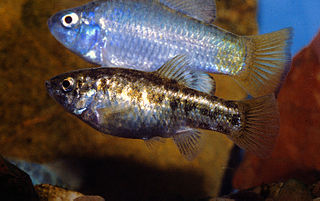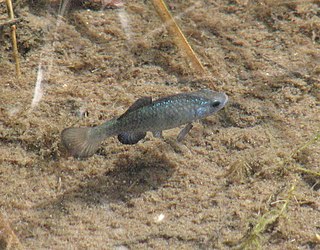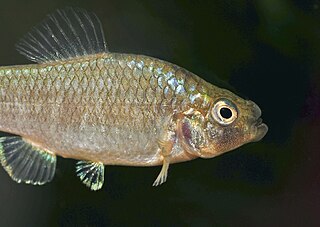
The Death Valley pupfish, also known as Salt Creek pupfish, is a small species of fish in the family Cyprinodontidae found only in Death Valley National Park, California, United States. There are two recognized subspecies: C. s. salinus and C. s. milleri. The Death Valley pupfish is endemic to two small, isolated locations and currently classified as endangered.

The Tecopa pupfish is an extinct subspecies of the Amargosa pupfish. The small, heat-tolerant pupfish was endemic to the outflows of a pair of hot springs in the Mojave Desert of Inyo County, California. Habitat modifications, the introduction of non-native species and hybridization with the related Amargosa River pupfish led to its extinction around 1979.

The Devils Hole pupfish is a critically endangered species of the family Cyprinodontidae (pupfishes) found only in Devils Hole, a water-filled cavern in the US state of Nevada. It was first described as a species in 1930 and is most closely related to C. nevadensis and the Death Valley pupfish. The age of the species is unknown, with differing analyses offering ranges between one thousand and sixty thousand years. It is a small fish, with maximum lengths of up to 30 mm (1.2 in). Individuals vary in coloration based on age and sex: males are bright metallic blue while females and juveniles are more yellow. A defining trait of this species is its lack of pelvic fins. The pupfish consumes nearly every available food resource at Devils Hole, including beetles, snails, algae, and freshwater crustaceans, with diet varying throughout the year. It is preyed on by the predaceous diving beetle species Neoclypeodytes cinctellus, which was first observed in Devils Hole in 1999 or 2000. Reproduction occurs year-round, with spikes in the spring and fall. Females produce few eggs, though, and the survivorship from egg to adult is low. Individuals live 10–14 months.

Cyprinodon is a genus of pupfishes found in waters that range from fresh to hypersaline. The genus is primarily found in Mexico, the Caribbean Islands and southern United States, but C. variegatus occurs as far north as Massachusetts and along the entire Gulf of Mexico coastline, and C. dearborni and C. variegatus are found in northern South America. Many species have tiny ranges and are highly threatened, in some cases already extinct. Cyprinodon are small; the largest reaches 10 cm (3.9 in) in length and most other species only reach about half that size.
Robert Rush Miller was an important figure in American ichthyology and conservation from 1940 to the 1990s."
Bolson pupfish is a species of freshwater fish in the family Cyprinodontidae.
Blackfin pupfish is a species of fish in the family Cyprinodontidae. This pupfish is endemic to Lake Chichancanab in Quintana Roo, Mexico. In almost all places, different Cyprinodon species do not overlap in their range, but there are two notable exceptions and one of these is Lake Chichancanab, which is inhabited by C. beltrani, C. esconditus, C. labiosus, C. maya, C. simus, C. suavium and C. verecundus. Among the endemic Cyprinodon species in Lake Chichancanab, only C. beltrani and C. labiosus still occur in some numbers in their habitat, while the remaining are virtually—if not fully—extinct in the wild. This species feeds on detritus. Compared to the other species of pupfish mentioned previously, the C. beltrani prefer a different feeding substrate. In regards to mating, the female blackfin pupfish seems to mate with other species of pupfish and not just the C. beltrani. The male blackfin pupfish have similar markings and courting behaviors to other pupfish in their habitat. The person honored in the specific name of this pupfish is the Mexican biologist Enrique Beltrán Castillo (1903–1994) to mark his quarter century of being a biologist.
The Leon Springs pupfish is a species of fish in the family Cyprinodontidae. It is endemic to Pecos County, Texas in the United States. It is a federally listed endangered species.

The Comanche Springs pupfish is a species of pupfish in the family Cyprinodontidae. It is endemic to Texas, and is now found only in spring-fed pools near Balmorhea, a small town in West Texas.
The Mezquital pupfish is a species of pupfish in the family Cyprinodontidae. It is endemic to Durango in Mexico. This species was described by Robert Rush Miller in 1976 from a pond which was fed by hot springs within the basin of the Río del Tunal, approximately 9 kilometres (5.6 mi) east of Durango City at an altitude of about 1,880 metres (6,170 ft). The specific name honors the American ichthyologist Seth Eugene Meek (1859-1914), a pioneer of the study of the freshwater fish of Mexico.

The Pecos pupfish is a species of pupfish in the family Cyprinodontidae. It is endemic to the Pecos River watershed in eastern New Mexico and western Texas in the United States.

The Owens pupfish is a rare species of fish in the family Cyprinodontidae, the pupfish. It is endemic to California in the United States, where it is limited to the Owens Valley. It is a federally listed endangered species of the United States. This pupfish is up to 5 centimetres long, the largest males sometimes longer. The male is blue-gray, turning bright blue during spawning. The female is greenish brown with a silvery or whitish belly.
The largefin pupfish, also known as cachorrito de dorsal larga, is a small species of pupfish in the family Cyprinodontidae. It is endemic to Lake Chichancanab in Quintana Roo, Mexico. In almost all places, different Cyprinodon species do not overlap in their range, but there are two notable exceptions and one of these is Lake Chichancanab, which is inhabited by C. verecundus, C. beltrani, C. esconditus, C. labiosus, C. maya, C. simus and C. suavium. Living together, the Cyprinodon species in Lake Chichancanab have diverged into different niches. Pupfish typically feed on algae and detritus. In Lake Chichancanab, however, C. verecundus has become an amphipod- and bivalve-eater.

The Catarina pupfish was a diminutive species of fish in the family Cyprinodontidae, first described in 1972. It was endemic to a spring in Nuevo León, Mexico. In an attempt of saving the rapidly declining species, some were brought into captivity in the late 1980s and early 1990s, but it proved very difficult to maintain. In 1994 it became extinct in the wild. Gradually the captive populations also perished. The last male died in 2014 and the species became extinct.

The desert pupfish is a rare species of bony fish in the family Cyprinodontidae. It is a small fish, typically less than 7.62 cm (3 in) in length. Males are generally larger than females, and have bright-blue coloration, while females and juveniles are silvery or tan. A notable attribute of the desert pupfish is their ability to survive in environments of extreme salinity, pH, and temperature, and low oxygen content. The desert pupfish mates in a characteristic fashion, wherein compatible males and females will come in contact and collectively jerk in an s-shape. Each jerk typically produces a single egg that is fertilized by the male and deposited in his territory. Breeding behavior includes aggressive arena-breeding and more docile consort-pair breeding.

The Sonoyta pupfish or Quitobaquito pupfish is an endangered species of pupfish from Sonora in Mexico and Arizona in the United States.

Cyprinodon nevadensis is a species of pupfish in the genus Cyprinodon. The species is also known as the Amargosa pupfish, but that name may also refer to one subspecies, Cyprinodon nevadensis amargosae. All six subspecies are or were endemic to very isolated locations in the Mojave Desert of California and Nevada.
Cyprinodon arcuatus is a species of fish in the family Cyprinodontidae. It was endemic to the Santa Cruz River in Arizona. It has been declared extinct as of 2011.

Cyprinodon desquamator is a scale-eating species of pupfish in the genus Cyprinodon. It is endemic to hypersaline interior lakes on San Salvador Island, Bahamas. It coexists alongside two other closely related Cyprinodon species C. brontotheroides and C. variegatus. Together, these three species represent a recent adaptive radiation, each having moved into a difference niche within their specialized environment. Each of these species are defined by distinct trophic adaptations that have affected various aspects of their functional morphology, behavior, strike kinematics, and reproductive coloration.

Cyprinodon brontotheroides is a species of pupfish in the genus Cyprinodon.













